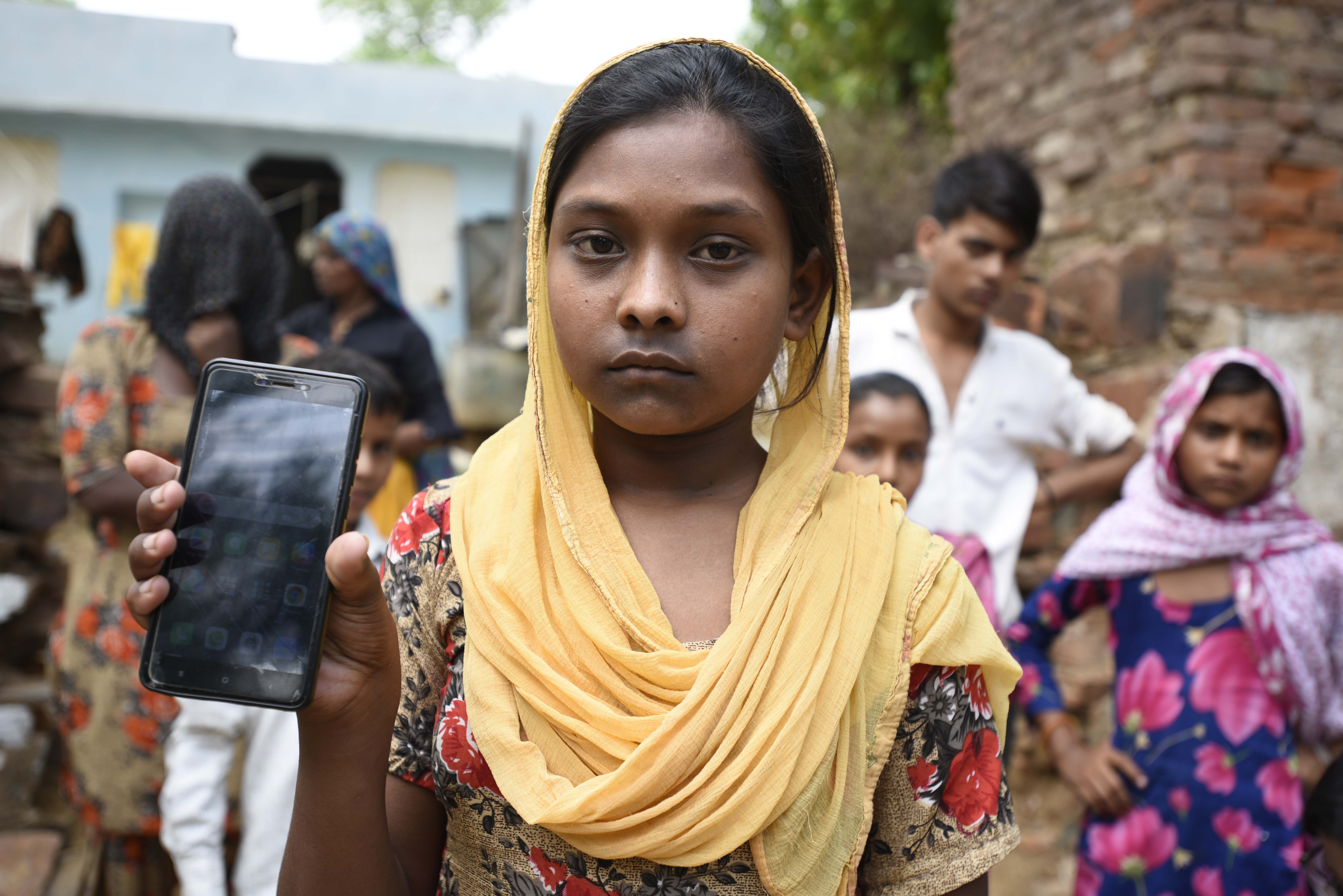As Indian Classes Go Online, Those Who Can’t Afford Smartphones Go Without
August 7, 2020Last week, a woman named Rita Bhoi from the east Indian state of Odisha sold a pair of gold earrings to buy a smartphone. “The earrings were given to me by my father when I got married,” she told VICE News. “I thought I’ll give it to my daughter when she gets married.”
Bhoi’s husband, Gagan, a labourer, has been without work for three months due to the lockdown. Their only source of food is the state government’s free rations, while a loan of almost US$650 looms over them.
Bhoi said that despite the couple’s financial instability, they absolutely needed the smartphone for her kids’ education. “I had to walk two kilometres to a friend’s house just to get homework and online classes done before this phone came home,” Archita, 13, Bhoi’s daughter, told VICE News. “There was pressure to keep up with studies.”
A week before Bhoi sold her jewellery, a man called Kuldeep Singh in the north Indian state of Himachal Pradesh sold his cow—his only source of livelihood—to pay off the loan he took to also buy a smartphone for his daughter’s online classes.
In March 2020, schools across India were shut down in line with the nationwide lockdown to mitigate the spread of COVID-19. UNESCO estimates that the school closures have affected 320 million Indian students. Out of those, the poor have been disproportionately impacted not just by closures of schools, but by an aggressive push by schools and states to introduce online classes.

India is a country of 1.3 billion people, with around 70 percent living in rural areas. Of that number, some 500 million of them are smartphone users as of December 2019, while 829 million are expected to have a smartphone by 2022. The latest data from India Cellular and Electronics Association estimated that in 2018, only 25 percent of rural India had access to a smartphone.
In some cities, education department officials are distributing smartphones and tablets to facilitate e-learning in government schools. On August 3, the Indian Government’s Ministry of Human Resource Development launched an “alternative” classroom calendar prepared by the National Council of Educational Research and Training (NCERT), which includes lesson plans accessible via smartphone, social media, SMS, television and radio.
On the other hand, the southern Indian state of Karnataka is regulating and restricting online classes after attempting to ban it altogether citing mental health impact on young children.
In many institutions, online classes and exams have been made mandatory, prompting protests from parents and students. The HRD Ministry eventually released guidelines for online classes, focussing on capping screen time.
In an interview with news outlet People’s Archive of Rural India, Bhau Chaskar, a schoolteacher and activist from the state of Maharashtra, said that the kids who can’t afford costly gadgets “could develop an inferiority complex”.
VICE News found at least 12 news reports between May 29 and August 2, wherein students—mostly teenagers—allegedly died by suicide because they didn’t have access to smartphones for online classes.
According to the latest National Crime Records Bureau, at least one student died by suicide every hour in 2018. There is no consolidated data on deaths by suicide during the pandemic. On July 9, State Crime Records Bureau data from the south Indian state of Kerala revealed that 66 school-age children died by suicide in the state since March 25—the day of the lockdown.
Akhila V Nair, the manager of DISHA, a counselling and mental health helpline in Kerala, told VICE News that there has been a spike in distress calls from parents from both rural and urban pockets. While urban parents mostly sought help with smartphone addiction, those in rural areas were distressed over not having internet and network for online classes.
“Some parents said they don’t have televisions, where the state broadcasts classroom lessons,” said Nair. “Many school children, from both urban and rural pockets, called us because they were stressed about how to prepare for online classes.”
Kerala's General Education Department found that 260,000 students—of the 4.3 million surveyed in the state’s government schools— didn’t have facilities for online classes. In response, the state started educational classes called ‘First Bell’ on television in June. Private individuals and civil society started a television donation drive to assist the move.
The same month, a year 10 student died by suicide in the Malappuram district of the state, reportedly because her family could not afford a TV or a smartphone.
However, as the students of Landimala village in the Sambalpur district of Odisha have discovered, owning a device is only half the story. In order to attend online classes, school children routinely climb a 150-foot water tank to connect with a mobile tower 12 km away.
In the Tsuruhu village in the northeastern state of Nagaland, as many as 39 school and college students have been trekking three kms to take online exams for the last two weeks.
Data shows that India’s urban population, which makes up 34 percent of the country, has an internet density — meaning the number of internet subscribers per 100 people — of 97.9 percent, while 66 percent of rural Indians have an internet density of just 25.3 percent.
A COVID-19 Rapid Assessment report by the NGO Save the Children (STC) found that 14 percent of the children in 7,006 surveyed households could not avail online education because they had no mobile and network. The survey, shared with VICE News, was conducted in 15 Indian states.
In June, several state governments flagged the problem of online classes in a meeting with India’s Human Resource Development Ministry. The state of Rajasthan reported that five percent of students don’t own a digital device, while 30 percent of Jharkhand has poor internet. In the Union Territory of Jammu & Kashmir—where the internet is restricted to 2G because of security reasons—students and teachers lag behind.
On July 22, a Delhi High Court heard that an online open book exam got interrupted because the Delhi University counsel’s computer hung. “We judges at the heart of Delhi also face connection issues. One can only imagine what will happen to students in remote areas,” the court reportedly said.
There is a section that believes that online teaching is no substitute for education. “Education is a social and human process; technology cannot mediate it effectively,” wrote Anurag Behar, the CEO of non-profit Azim Premji Foundation, in the Mint newspaper.
“Children learning to bake from the net is wonderful, but it is not education. Heavily marketed apps may help a child learn something, often because of energetic parents, but that is also not education. Online resources are useful tools, but are also not education,” he wrote.
Experts worry that the pandemic could be a final blow to India’s damaged education system. In its surveys since 2005, Pratham, an educational non-profit, found that Indian schools witnessed high instances of dropouts, low attendance and below-par levels of learning.
In 2019, Pratham reported that only 16 percent—out of 37,000—children studying in year one in 26 surveyed rural districts could read text at the prescribed level, while almost 40 percent could not even recognise letters of the alphabet.
Smitin Brid, the director of Early Childhood Programs with Pratham, said that in order to ensure children in Pratham’s network are learning, the organisation had to “go back in technology” and distributed learning material via SMS, radio and loudspeakers. They also involved youth volunteers and mothers’ groups to engage with children during the closures.
The dangers of kids slipping through the cracks in the already-overwhelmed system are high.
Last week, social welfare department officials in Avinashi town, in district of Tirupur in the south Indian state of Tamil Nadu, found 70 minors locked up in a private mill. They were reportedly brought under the pretext of earning between INR 4,000-5,000 (US$ 53.4-US$66.7) per month.
A report by the International Labor Organization and United Nations Children’s Fund stated that parental unemployment and school closures during the pandemic has pushed 152 million children into child labour—setting progress back years. “With the jobs going and economic pressures in families, the issue of learning loss will only increase,” said Brid.
Archita Bhoi, the girl from Odisha, told VICE News that she prefers her normal classes over her smartphone. “I miss the atmosphere. The teachers teach better, and I clear my doubts too. Right now, I’m just managing.”
Follow Pallavi Pundir on Twitter.


